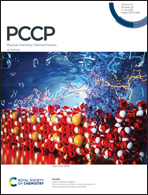Mechanistic implications of Li–S cell function through modification of organo-sulfur cathode architectures†
Abstract
Copolymeric organo-sulfur based electrodes provide a unique framework to explore and subsequently improve lithium–sulfur (Li–S) cells. There is a general difference in the way copolymers trap lithium during cell function compared to inorganic carbon–sulfur composites. Using a chain-like polyterpene copolymeric architecture involving the copolymerization of squalene monomer with sulfur (poly(S-r-squalene)), the first evidence for distinguishable differences in the entrapment of lithiated species, when using different copolymeric architectures, is provided. Investigation of poly(S-r-squalene) as an active cathode material via X-ray Absorption Near-Edge Structure (XANES) spectroscopy and high-resolution solid-state Nuclear Magnetic Resonance (NMR) reveal notable differences compared to previously studied poly(S-r-DIB) (proposed to have a less branched architecture) between the lithium environments present during electrochemistry that can be directly linked to the copolymeric structural features. Subtle but pertinent effects based on the copolymeric architecture related to the solid–electrolyte interphase (SEI) formed from the electrolytic components are also uncovered through these techniques. This work offers a comprehensive study on poly(S-r-squalene) and reveals that foundational inverse vulcanisation conditions such as choice of crosslinking monomer can dramatically impact lithium transport and SEI formation for the copolymeric electrode.



 Please wait while we load your content...
Please wait while we load your content...